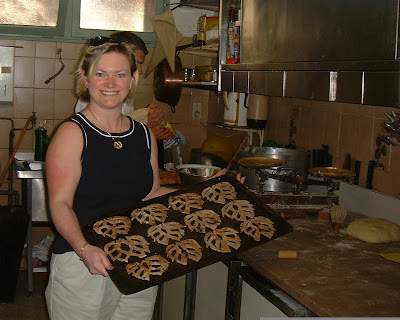
I was reading a fellow colleague's new blog, Hodding Carter, the Frugal Guy, formerly of Gourmet Magazine, and read his post on the cheese bread sticks he makes for his kids. In a rare slip for this erudite writer, he called them fougasses.
Well, to correct misunderstandings, I thought I'd put on a post about the local flatbread of Provence, aka, la fougasse. When you wander into a bakery in search of a savory (or sweet as the case might be) nibbly, this is an excellent choice.
I've taken many clients to my favorite bakery for a short class in making Fougasse and other local bread pastries. It's a favorite visit, as before we get going kneading dough ourselves, we get to be flies on the wall, observing and admiring the intricate choreography of a three bakers swirl around we the intruders, baking trays in hand, cookies, breads, cakes, and more efficiently being made one right after the other with barely a moment's breather between and amongst the many tasks and recipes. The baker seems to be the rare man who can multi-task with grace and skill.

The Fougasse is etymologically related to the Italian Focaccia. You can recognize it immediately by its Jacob's ladder shape.
Before your eyes in that aforesaid bakery, you will often have a selection of flavors before you: plain with a touch of powdered sugar (aka la pompe à l'huîle), olive, cheese (usually gruyère), anchovy paste, and pork (or duck) cracklings, gratillons. The pompe a l’huîle is one of the thirteen desserts of the Christmas meal, thus, every local baker has his variation of this regional classic.

Rabelais wrote of the Fouasse in Gargantua, and there are likely other variants on this word elsewhere in the Mediterranean.
I've put two recipes here for you to try, a classic bread dough that can be added to, and the olive oil and butter enriched pompe à l'huîle.
Enjoy!
Bread dough style Fougasse
Mix the following together, knead for 15 minutes and let sit overnight in the refrigerator wrapped up in plastic to prevent a crust from forming and the dough from drying out.
• 500 grams of bread flour (2 1/4 cups)
• 10 grams of salt (1/2 teaspoon)
• 20 -30 grams of bakers' yeast in cakes (more in the winter, less in summer)
• 200-250 grams of water (1 cup or a bit more) as needed
The next day, take out your dough, cut into sections, roll it out to a third to a half inch thick. To add pork or duck cracklings, lay them in the flattened dough, fold as you would for croissants, roll out, then fold again, roll out again. Or you could sprinkle some cheese and sun dried tomatoes on the top, or a bit of olive bits, olive oil and herbs, or honey and herbs and olive oil , tapenade... Make your cuts in a pattern such as you see in the pictures to allow you to open your dough up to the lattice shape.

Let rise 30 minutes in a warm place till just filled out. Place in a hot oven (200C/420F) and bake for 10 minutes or until just golden on top.
La pompe à l'huîle
* 500 grams (2 and 1/4 cups) all purpose flour
* 50 grams (1/4 cup) granulated sugar
* 50 grams bakers' yeast in cubes (prefered to packet yeast)
* 10 grams salt (1/2 teaspoon)
* 200 grams water (1 cup)
* 150 grams olive oil (2/3 cup)
On a smooth surface, marble, granite, or even formica, place your flour with two wells. In one well crumble up the cake yeast and in the other well, place the sugar and the salt. Mix the water and olive oil together in a pitcher, then, careful to stay inside the well, pour about 1/2 of the liquid mixture in. With one hand gradually blend the yeast, sugar, salt and liquid with a bit of the surrounding flour, continue. Add more of the liquid mixture as needed (depending on your flour and depending on the room temperature, you will use all or only some of the liquid). Keep working with only one hand and as needed, use a pastry scraper to gather the rest of the flour from your surface, and to scrape your hand clean. When all the ingredients have come together, start working and kneading your dough with both hands. You can fold it, slap it back down onto your surface hard, fold it and press it some more, slap it down again. For about 5-10 minutes.
Put your dough aside for 10-15 minutes to rest, ideally beside your oven or even in an oven that has cooled to warm. Once the dough has rested, roll it into a 2 inch in diameter length, and cut your sections. roll out the sections into squares, triangles or circles as you prefer, make your cuts, stretch out the cut dough, place on a prepared cookie sheet, and let rise again for 15 minutes till only gently filled out.
Place in a hot oven (200C/420F) for 5-10 minutes till just browned on top. Remove and enjoy.
No comments:
Post a Comment